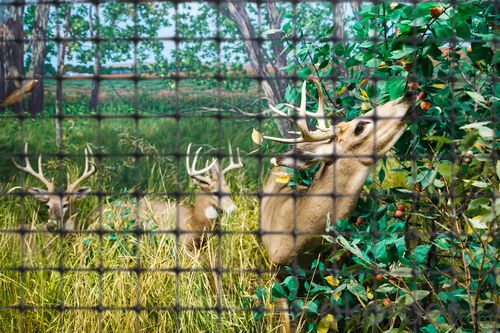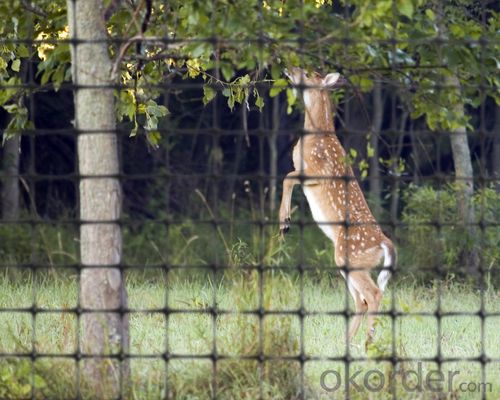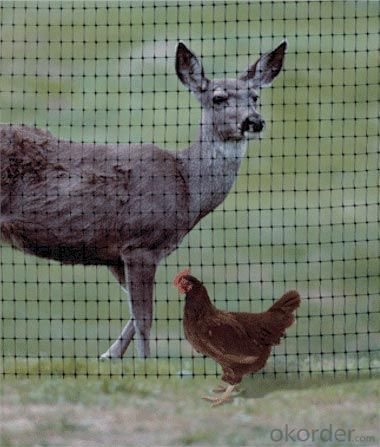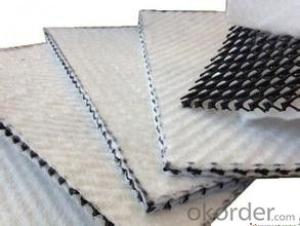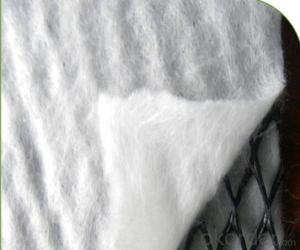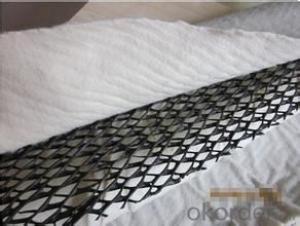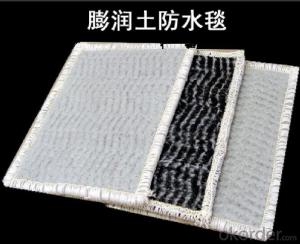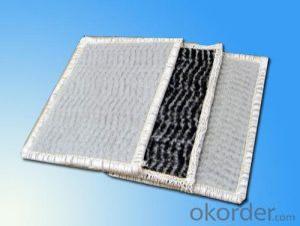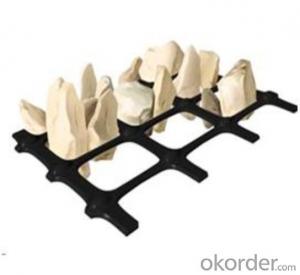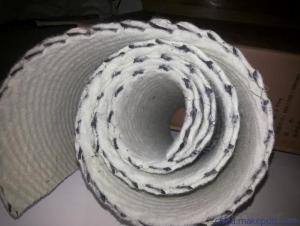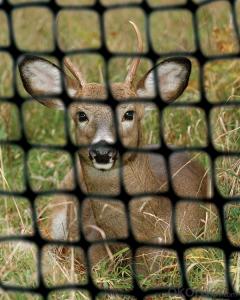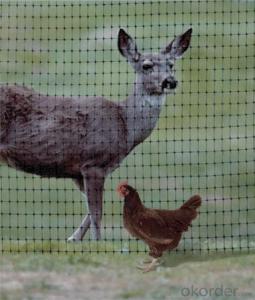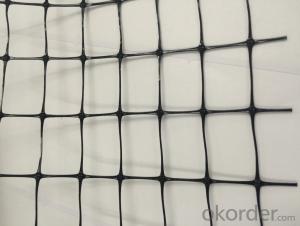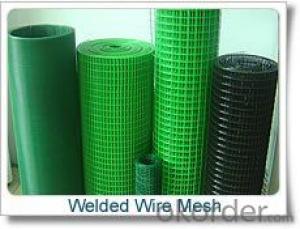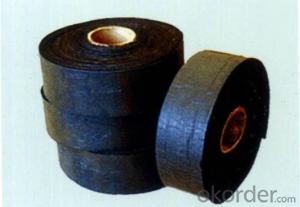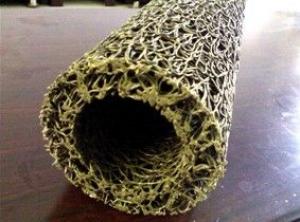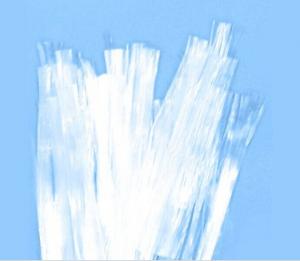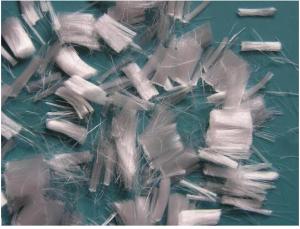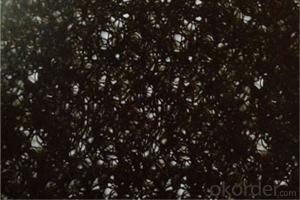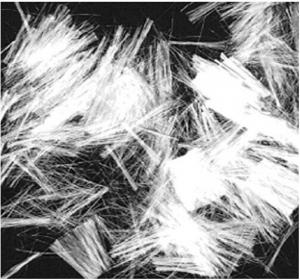PP Plastic Netting/ Deer Netting/ Garden Netting
- Loading Port:
- China main port
- Payment Terms:
- TT OR LC
- Min Order Qty:
- 5000 m²
- Supply Capability:
- 1000000 m²/month
OKorder Service Pledge
OKorder Financial Service
You Might Also Like
Plastic netting plastic mesh breeding mesh
Plastic Plain Netting
Colour:white,black,blue and green
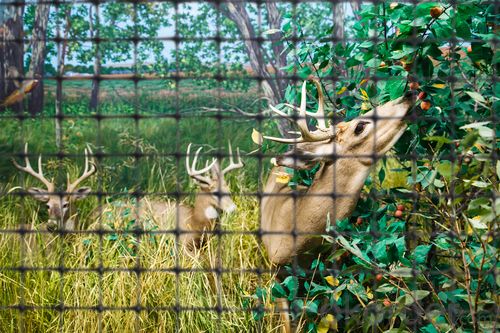

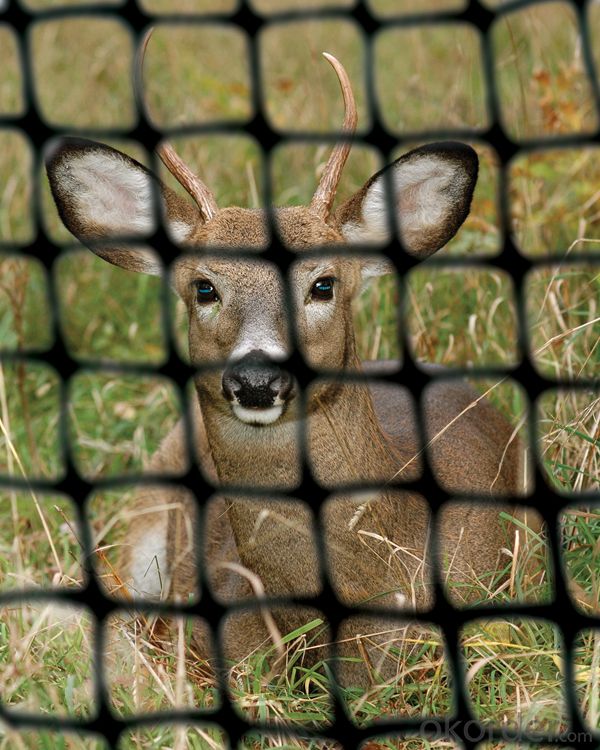
Deer fence introduction:
Deer fencing is a very high strength, lightweight, 3.6ft to 7.3ft high deer fence manufactured from high strength polypropylene BOP plastic netting. Deer have a tendency to forage over large areas and the cost effective deer fencing offers a very effective deer control barrier.
The deer fence is black, UV stabilised and rot proof and unobtrusive as it merges into it's background. Deer fencing is very quick and easy to erect and each roll weighs less than 15kg. The Deer Netting should be installed by battening to the fencing posts to ensure the mesh filaments are not damaged.
Features of the deer neeting fence:
Deer fence is easy to erect and install
Plastic netting has a mesh hole size of 0.06" ,0.08",0.18",0.19"
The BOP plastic netting has a high tensile strength
Plastic mesh is UV stabilized and chemical resistant
Deer fencing rolls are lightweight
Deer fencing is a very high strength, lightweight 1.8m high Deer fence manufactured from polypropylene.
Deer fencing net is supplied on a 100m long roll
Features:
1. Low cost, while has superior strength
2. Has anti-tearing and friction capability
3. Wide range of product availability, some other mesh sizes and weights can also produced as per customers' requirements.
Package/Payment/Delivery:
Package: Usually packed by rolls in plastic film bags with labels inside and then loosely loaded in the container
Delivery: Within 40 to 60 days after receiving the deposit or L/C.
FAQ:
Q1: What is your minimum order quantity?
A:The minimum order quantity is 5000 ,but it is negotiable.
Q2:What is your payment terms?
A: T/T,Western Union,Paypal,L/C...
Q3:What is your delivery time?
A:Production time usually costs 2-20 days.
Waiting to cooperate with you!
- Q: Can geocells be used for erosion control on slopes?
- Yes, geocells can be used for erosion control on slopes. Geocells are three-dimensional honeycomb-like structures made from high-density polyethylene material. They are installed on slopes to provide stabilization and prevent soil erosion. The cells are filled with soil, aggregate, or vegetation, which helps to reinforce the slope and hold the soil in place. This solution is effective in preventing erosion and promoting slope stability.
- Q: Can earthwork products be used for creating artificial waterfalls?
- Yes, earthwork products can be used for creating artificial waterfalls. Earthwork products such as rocks, boulders, and soil can be strategically placed to construct the structure and shape of the waterfall. Additionally, these products can help in creating a natural-looking and aesthetically pleasing waterfall feature.
- Q: How are geocells used for load support in industrial yards?
- Geocells are used for load support in industrial yards by providing a stable and reinforced foundation for heavy equipment and vehicles. They are typically filled with aggregate material and placed on the ground surface to create a strong and durable support system. This helps distribute the load evenly, prevent soil erosion, and increase the overall stability of the yard, allowing for safe and efficient operations.
- Q: What are the advantages of using geosynthetic clay liners in wastewater treatment?
- Geosynthetic clay liners provide several advantages in wastewater treatment. Firstly, they offer excellent hydraulic conductivity, preventing the leakage of wastewater into the surrounding environment. Secondly, they possess high chemical resistance, ensuring the liner remains intact even in the presence of harsh chemicals commonly found in wastewater. Additionally, geosynthetic clay liners are highly durable and have a long lifespan, minimizing the need for frequent replacements. Moreover, they are cost-effective compared to alternative liner materials. Overall, geosynthetic clay liners play a crucial role in protecting the environment, prolonging infrastructure life, and reducing operational costs in wastewater treatment facilities.
- Q: Civil engineering graduation, after work which test is good?
- Civil engineering professional research types and conditions First, after graduation a year after the automatic conversion to assistant engineers, as assistant engineers after four years of assessment engineers. If you are engaged in the construction of the building on the construction division to do a certain time after the test of a supervision engineer. If you engage in the settlement of the test on the cost division or economist. If you engage in the design of the architect or architect or rock division. A supervisor of the supervision of the engineers. Of course, can more work to more test on the test. The supervisor of the maximum number of years so the final test budget, construction workers, quality inspectors, security officers, materials
- Q: Can earthwork products be used for creating raised garden beds?
- Yes, earthwork products can be used for creating raised garden beds. Earthwork products such as topsoil, compost, and fill dirt can be used to build up the bed's height and create a suitable growing environment for plants. Additionally, materials such as gravel or stone can be used for constructing the bed's frame or pathways.
- Q: Material molding and control technology and civil engineering is not near professional?
- No, one belongs to the material college, there are civil is not, are very good, very different.
- Q: What are the advantages of using geosynthetic clay liners?
- Geosynthetic clay liners offer several advantages, including excellent hydraulic performance, high tensile strength, and resistance to puncture and chemical degradation. They provide an effective barrier to prevent the migration of contaminants, reduce seepage, and enhance the stability of slopes and embankments. Additionally, these liners are lightweight, easy to install, and cost-effective compared to traditional clay liners.
- Q: Can earthwork products be used for creating outdoor seating in parks?
- Yes, earthwork products such as soil, gravel, or rocks can be utilized for creating outdoor seating in parks. These materials can be shaped and arranged to build benches, seating walls, or terraces, providing functional and natural seating options for park visitors.
- Q: Can earthwork products be used for creating outdoor fire pits?
- Yes, earthwork products can be used for creating outdoor fire pits.
Send your message to us
PP Plastic Netting/ Deer Netting/ Garden Netting
- Loading Port:
- China main port
- Payment Terms:
- TT OR LC
- Min Order Qty:
- 5000 m²
- Supply Capability:
- 1000000 m²/month
OKorder Service Pledge
OKorder Financial Service
Similar products
Hot products
Hot Searches
Related keywords






